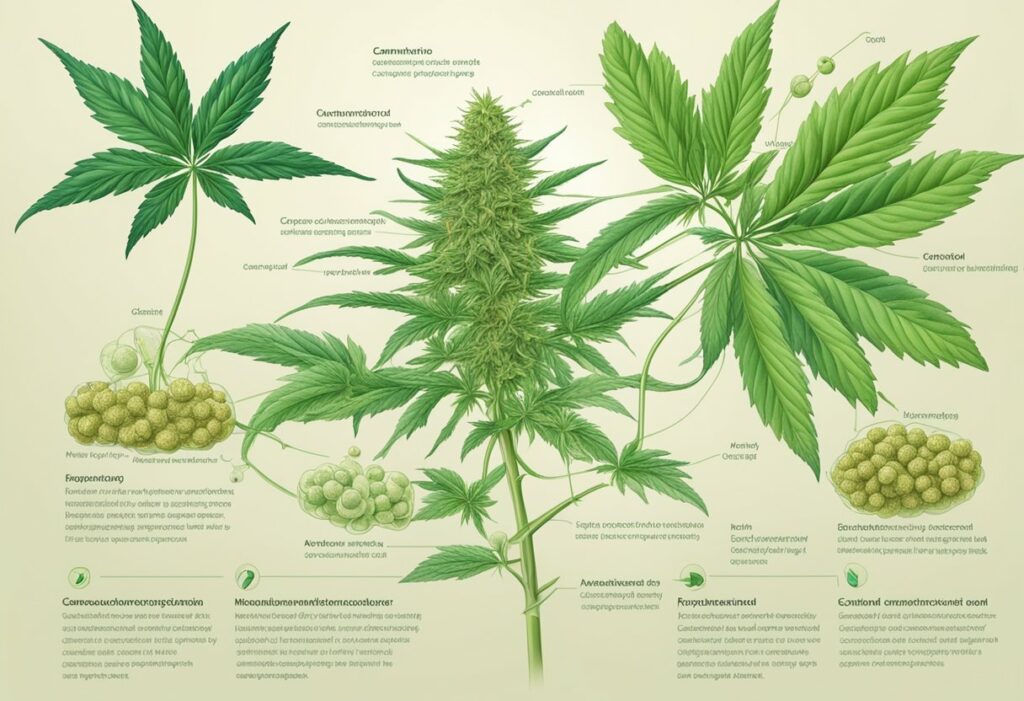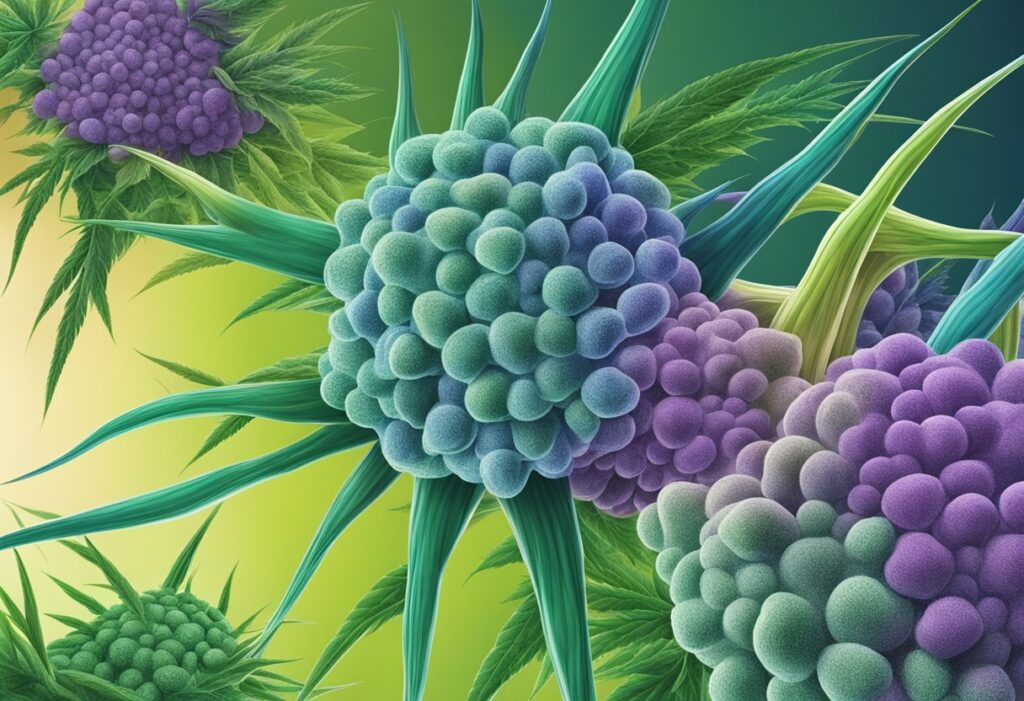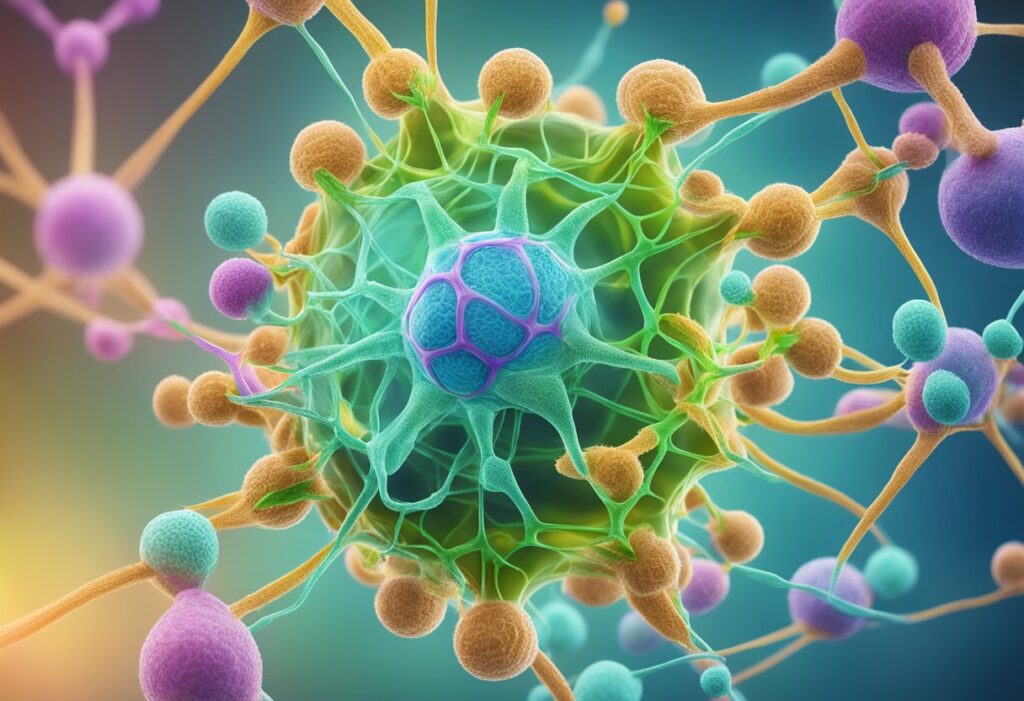Cannabinoid receptors are a vital component of the endocannabinoid system, which plays a significant role in regulating various physiological and cognitive processes in the body. These receptors are proteins found on the surface of cells and are activated by cannabinoids, both naturally occurring (endocannabinoids) and those found in the cannabis plant (phytocannabinoids). They are widely distributed throughout the central and peripheral nervous systems and are involved in diverse functions, including pain management, mood regulation, and immune response.
Two primary types of cannabinoid receptors have been identified: CB1 and CB2. CB1 receptors are primarily found in the brain and central nervous system, while CB2 receptors are mainly found in the immune system and peripheral tissues. Both receptors are crucial for maintaining homeostasis within the body and are involved in many of the therapeutic effects attributed to cannabis and its derivatives.
Key Takeaways
- Cannabinoid receptors are essential components of the endocannabinoid system, playing a role in regulating various physiological and cognitive processes.
- CB1 and CB2 receptors are the primary types of cannabinoid receptors, with CB1 found mostly in the central nervous system and CB2 in the immune system and peripheral tissues.
- The activation of these receptors maintains homeostasis in the body and contributes to many therapeutic effects of cannabis and its derivatives.
Cannabinoid Receptor Basics
Cannabinoid receptors are an essential component of the endocannabinoid system (ECS), which plays a crucial role in regulating various physiological processes. These receptors are primarily divided into two types: CB1 and CB2 receptors, each with their unique functions in the central and peripheral nervous system. In this section, we will discuss the basics of these two types of cannabinoid receptors.
CB1 Receptor
The CB1 receptor is predominantly found in the central nervous system (CNS) and, to a lesser extent, in peripheral tissues. This receptor plays a crucial role in modulating neurotransmitter release, thereby regulating various physiological functions, such as:
- Learning and memory
- Pain perception
- Appetite regulation
- Motor function
These receptors are primarily activated by endogenous cannabinoids, such as anandamide, as well as exogenous cannabinoids, like THC (the primary psychoactive component in cannabis). It is important to highlight that the CB1 receptor is also the target of several therapeutic drugs developed to treat conditions, such as chronic pain and obesity, by modulating its activity.
CB2 Receptor
The CB2 receptor is primarily found in the peripheral nervous system, especially in the immune cells. Unlike the CB1 receptor, the CB2 receptor does not have a significant presence in the CNS, and therefore, its activation does not result in psychoactive effects.
CB2 receptors are involved in the regulation of immune responses, such as modulating the release of pro-inflammatory and anti-inflammatory cytokines. Activation of CB2 receptors has been associated with several therapeutic benefits, including:
- Anti-inflammatory effects
- Protection against tissue injury and damage
- Immune modulation
- Pain relief
Similar to CB1 receptors, the CB2 receptor can also be activated by endogenous cannabinoids, as well as exogenous cannabinoids like CBD (a non-psychoactive component in cannabis). Research is ongoing to develop therapeutic drugs targeting CB2 receptors for various inflammatory and immune-related disorders.

Cannabinoids and Ligands
Endocannabinoids
Endocannabinoids are naturally occurring compounds found within the body that interact with cannabinoid receptors. The two most well-known endocannabinoids are anandamide and 2-arachidonoylglycerol (2-AG). Anandamide, also known as the “bliss molecule,” plays a vital role in regulating mood, appetite, and pain perception. 2-AG, on the other hand, is involved in various physiological processes, such as immune system function and neuroprotection.
Phytocannabinoids
Phytocannabinoids are plant-derived cannabinoids found primarily in the Cannabis sativa plant. The two most studied phytocannabinoids are delta-9-tetrahydrocannabinol (Δ9-THC) and cannabidiol (CBD). Δ9-THC is the main psychoactive component of cannabis and is responsible for the plant’s mind-altering effects. In contrast, CBD is not psychoactive and has gained popularity for its potential therapeutic applications, such as relieving anxiety, inflammation, and pain.
Synthetic Cannabinoids
Synthetic cannabinoids are chemically engineered compounds designed to mimic the effects of natural cannabinoids. These substances bind to the same receptors as naturally occurring cannabinoids but often produce much stronger and unpredictable effects. Synthetic cannabinoids can be found in products such as “spice” or “k2” and are typically more potent than their plant-derived counterparts.
Cannabinoids and their receptor affinity:
| Compound | CB1 Receptor Affinity | CB2 Receptor Affinity |
|---|---|---|
| Anandamide | Moderate | Moderate |
| 2-AG | Moderate | Moderate |
| Δ9-THC | Strong | Weak-Moderate |
| CBD | Weak | Weak-Moderate |
| Synthetic Cannabinoids | Variable | Variable |
The interaction between cannabinoids and their respective ligands plays a crucial role in regulating various physiological processes. Understanding the differences between endocannabinoids, phytocannabinoids, and synthetic cannabinoids helps to appreciate their distinct effects on the body and potential therapeutic applications.
Endocannabinoid System Functioning
Signal Transduction
The endocannabinoid system (ECS) plays a crucial role in the regulation of various physiological processes in the central nervous system and throughout the body. The key components of the ECS are the cannabinoid receptors, primarily CB1 and CB2, which are G protein-coupled receptors. These receptors are activated by both endogenous cannabinoids (endocannabinoids) and exogenous cannabinoids found in the cannabis plant, such as THC and CBD.
When a cannabinoid binds to a receptor, it triggers a conformational change in the receptor, activating a G protein. This activation results in a cascade of downstream signaling events, which often involve the inhibition of adenylyl cyclase, leading to a decrease in intracellular cAMP levels. Additionally, the activation of cannabinoid receptors can also modulate neurotransmitter release, such as GABA.
Homeostasis Regulation
A prominent function of the ECS is the maintenance of homeostasis, the balance of various physiological processes within the body. The ECS acts as a “master regulatory system” that helps maintain this balance through a variety of mechanisms, including the regulation of:
- Immune system function
- Pain perception
- Inflammation
- Mood and stress response
- Sleep
- Appetite
The endocannabinoid system oversees this regulation by monitoring crucial physiological systems in the body and ensuring their proper functioning.
Enzymatic Breakdown
Enzymes play a crucial role in the functioning of the ECS, as they are responsible for the synthesis and breakdown of endocannabinoids. The two primary enzymes involved in the regulation of the endocannabinoid system are fatty acid amide hydrolase (FAAH) and monoacylglycerol lipase (MAGL)4. These enzymes are responsible for breaking down the most common endocannabinoids, anandamide (AEA) and 2-arachidonoylglycerol (2-AG), respectively.
Through the synthesis and degradation of these endocannabinoids, the enzymatic processes within the ECS help regulate and maintain the balance of various physiological systems, ensuring that they function smoothly.
Clinical Relevance of Cannabinoid Receptors
Cannabinoid receptors play a crucial role in various physiological processes, making them potentially valuable targets for therapeutic interventions. This section highlights the significance of these receptors in the treatment of pain, inflammatory disorders, mood and anxiety disorders, and neurodegenerative diseases.
Pain Management
Cannabinoids, particularly those that target the CB1 and CB2 receptors, have shown potential in the management of different types of pain. Evidence suggests that they can alleviate both acute and chronic pain, including neuropathic pain. Activation of cannabinoid receptors results in the inhibition of neurotransmitter release, which subsequently modulates pain perception and contributes to the analgesic effects. There have been several preclinical studies highlighting the potential therapeutic applications of cannabinoid receptor agonists in pain management.
Inflammatory Disorders
Cannabinoid receptors, particularly CB2, play a significant role in modulating immune responses and inflammation. Activation of CB2 receptors has been known to produce anti-inflammatory effects by suppressing the production of pro-inflammatory cytokines and inhibiting immune cell proliferation. Research has suggested that targeting CB2 receptors may be useful in the treatment of various inflammatory disorders such as rheumatoid arthritis, inflammatory bowel disease, and multiple sclerosis.
Mood and Anxiety Disorders
Cannabinoid receptors have also been implicated in the regulation of mood and stress responses. They are widely distributed in brain regions associated with emotion, cognition, and stress, suggesting a potential role in the treatment of mood and anxiety disorders. Some studies have indicated that cannabinoid receptor agonists and antagonists may possess anxiolytic and antidepressant properties, although further research is needed to establish the exact mechanisms and clinical importance of these effects.
Neurodegenerative Diseases
Research has demonstrated that cannabinoid receptors may play a role in the progression of various neurodegenerative diseases such as Parkinson’s disease, Huntington’s disease, Alzheimer’s disease, and multiple sclerosis. Activation of CB1 and CB2 receptors has been shown to exert neuroprotective effects, as they modulate neuroinflammation, oxidative stress, and excitotoxicity. This suggests that targeting these receptors could offer new therapeutic approaches for the treatment of these debilitating conditions. However, more comprehensive studies are required to determine the optimal strategies for exploiting the full therapeutic potential of cannabinoid receptors in neurodegenerative diseases.

Pharmacology and Drug Development
Receptor Agonists and Antagonists
The pharmacology of cannabinoid receptors involves the study of agonists and antagonists. Agonists are substances that activate the receptor, while antagonists block the receptor. Synthetic ligands, which are human-made molecules designed to interact with specific receptors, are often used in the development of drugs targeting cannabinoid receptors. One example of such a synthetic ligand is rimonabant, a selective CB1 receptor antagonist.
Modulators and Enzyme Inhibitors
In addition to receptor agonists and antagonists, the cannabinoid receptor system can be targeted using allosteric modulators. An allosteric modulator is a molecule that binds to a receptor at a site different from the active site, but still influences receptor activity. ORG27569 is an example of an allosteric modulator specific to the CB1 receptor.
Furthermore, the endocannabinoid system also consists of enzymes responsible for the synthesis and degradation of endocannabinoids. Inhibiting these enzymes can result in increased endocannabinoid levels, thus modulating the receptor’s activity. For example, blocking the enzyme fatty acid amide hydrolase (FAAH) can lead to increased levels of the endocannabinoid anandamide.
Clinical Trials and Therapeutics
Research in cannabinoid pharmacology has led to clinical trials aimed at exploring the potential therapeutic applications of drugs targeting the endocannabinoid system relating to cannabinoid receptors.
Some drugs have already been approved for use, including nabilone and dronabinol, which are synthetic THC analogs used to treat nausea and vomiting associated with chemotherapy. Some trials investigate the use of synthetic cannabinoids in treating chronic pain, multiple sclerosis, and other neurological disorders.
In conclusion, the field of cannabinoid pharmacology and drug development continues to advance with a focus on receptor agonists, antagonists, modulators, and enzyme inhibitors. These developments contribute to a better understanding of the endocannabinoid system and offer hope for future therapeutics in various medical fields.
Physiological Effects and Behavioral Impact
Appetite and Metabolism
Cannabinoid receptors play a crucial role in regulating appetite and metabolism. The activation of these receptors, particularly CB1, has been shown to stimulate appetite and contribute to weight gain. They are known to influence energy balance and have a direct impact on how the body metabolizes food. Research suggests that cannabinoid receptor agonists can lead to increased food intake and body weight. On the other hand, antagonists of cannabinoid receptors have demonstrated potential for the treatment of obesity.
Learning and Memory
Cannabinoid receptors are widely distributed in the brain, with a high concentration in areas associated with the processes of learning and memory. Activation of the receptors can lead to both positive and negative effects on cognitive function. Some studies have shown that cannabinoids can enhance learning by modulating synaptic transmission and altering neural plasticity. However, excessive activation of the receptors, for instance, through the use of cannabis, may have detrimental effects on memory, impairing the ability to retain and process new information.
Addiction and Reward System
The endocannabinoid system, involving cannabinoid receptors, has been implicated in drug addiction and the reward system. Research has revealed the presence of these receptors in brain regions associated with the reinforcing properties of addictive substances. Activation of the receptors contributes to the overall process of addiction and may impact the following aspects:
- Reinforcing effects of drugs
- Drug-induced behavioral sensitization
- Relapse to drug-seeking behavior
Targeting the cannabinoid receptors, specifically with CB1 receptor antagonists, might hold promise for the development of novel therapies for addiction. However, further research is required to validate and expand on this potential treatment strategy.
Research Advances in Cannabinoid Receptors
Structural Biology
Significant progress has been made in recent years regarding the structural biology of cannabinoid receptors. The discovery of the crystal structure of the type-1 cannabinoid receptor (CB1) has provided invaluable insights into cannabinoid signaling and the interaction between cannabinoids and the receptor itself. This knowledge has been pivotal in understanding the physiological effects induced by cannabinoids found in Cannabis sativa and in developing synthetic cannabinoid drugs.
Genetics and Mutations
Research on the genetics and mutations of cannabinoid receptors has shed light on their clinical significance. The gene encoding the cannabinoid receptor 1, known as CNR1, has been studied extensively due to its critical role in cannabinoid signaling in the central nervous system. Alterations or mutations in this receptor gene have been implicated in various neuropsychiatric disorders and affect individual responses to cannabinoids, both natural and synthetic.
Here are some key aspects related to CNR1:
- Location: The CNR1 gene is located on chromosome 6.
- Function: This gene encodes the cannabinoid receptor 1, which is primarily expressed in the central nervous system. It plays a vital role in the endocannabinoid system, modulating various physiological processes such as pain perception, appetite regulation, and mood control.
- Mutations: Variations in the CNR1 gene have been linked to cognitive impairments, drug dependence, and several psychiatric disorders.
Innovative Therapies
Advancements in cannabinoid research have led to the development of innovative therapies targeting the endocannabinoid system. These new treatments are not limited to manipulating CB1 and CB2 receptors. They also involve exploring other components of the endocannabinoid system, such as enzymes, transporters, and endogenous ligands.
Some notable therapeutic developments include:
- Selective agonists and antagonists: These compounds are designed to target specific cannabinoid receptors, leading to fewer side effects compared to non-selective drugs.
- Allosteric modulators: These molecules bind to alternative sites on the cannabinoid receptors, enhancing or inhibiting their activity.
- Endocannabinoid reuptake inhibitors: These drugs prevent the breakdown of endogenous cannabinoids, prolonging their effects on the target receptors.
In conclusion, ongoing research on cannabinoid receptors has resulted in significant advances in the fields of structural biology, genetics, and innovative therapeutics. These discoveries are providing a deeper understanding of the endocannabinoid system and facilitating the development of more effective and precise treatments for various medical conditions.

Cannabinoid Receptors in the Immune System
Immunomodulation
Cannabinoid receptors, specifically CB1 and CB2, are found in various parts of the immune system, with CB2 receptors being more predominant in immune cells such as T cells, macrophages, and microglial cells. Research suggests that activation of these receptors can have immunomodulatory effects. For example, cannabinoids may inhibit the release of certain inflammatory mediators, thus decreasing inflammation.
In the context of immune response, several studies have shown that cannabinoid receptors play a regulatory role in the functioning of immune cells. The activation of CB2 receptors in these cells can lead to the modulation of cytokine release and various cell signaling pathways. This, in turn, affects the overall immune response and contributes to maintaining an immune system balance.
Infection and Immune Response
The role of cannabinoid receptors in the immune system extends to their involvement in the infection and immune response process. In some cases, cannabinoids may suppress the activation of immune cells, which can potentially impact the host’s ability to combat infections. On the other hand, in certain situations, cannabinoid receptor activation could enhance immune cell function when needed.
The presence of cannabinoid receptors in the immune system plays a significant role in immune modulation and regulation, with complex impacts on immune response and inflammation. Understanding how these receptors interact with immune cells and contribute to various immune-related processes will pave the way for potential therapeutic applications.
Frequently Asked Questions
What roles do CB1 and CB2 receptors play in managing pain?
CB1 and CB2 receptors are types of cannabinoid receptors found throughout the nervous system and immune system. They play a crucial role in pain management by modulating pain signals. CB1 receptors are primarily located in the brain and spinal cord, mediating the analgesic effects of cannabinoids like THC. CB2 receptors, on the other hand, are more prevalent in the immune system and peripheral tissues, where they help regulate immune response and inflammation, thus influencing pain perception. Both receptors work together to provide pain relief when activated by endogenous or exogenous cannabinoids.
How are cannabinoid receptors distributed throughout the brain?
Cannabinoid receptors, particularly the CB1 subtype, are highly expressed in various regions of the brain. Some key areas include the basal ganglia, hippocampus, cerebellum, and cerebral cortex. These brain regions are involved in essential functions such as motor control, learning, memory formation, emotion regulation, and higher cognitive processes. The distribution of CB1 receptors within the brain helps explain the diverse effects of cannabinoids on mood, cognition, and sensory perception.
What are the primary functions of cannabinoid receptors in the body?
Cannabinoid receptors play a significant role in modulating various physiological processes, including pain sensation, immune response, mood regulation, appetite, and memory formation. CB1 receptors primarily influence the central nervous system functions, while CB2 receptors mainly regulate the immune system and inflammation. By binding to these receptors, endogenous cannabinoids (endocannabinoids) or external cannabinoids (like THC and CBD) can alter neural signaling and help maintain a state of balance, or homeostasis, in the body.
In what ways do cannabinoids impact the immune system via its receptors?
Cannabinoids can influence the immune system through their interaction with CB2 receptors which are predominantly found on immune cells. When activated, these receptors can modulate immune cell functions, such as cytokine production, cell proliferation, cell migration, and inflammation. This interaction helps regulate immune responses and may have potential therapeutic implications for various immune-related disorders, such as autoimmune diseases, allergies, and chronic inflammation. A study on cannabinoid signaling in the immune system provides more insights into the possibilities and challenges in this field.
Which animals have been identified to possess cannabinoid receptors?
Cannabinoid receptors are not exclusive to humans; they have been identified in various animal species, including mammals, birds, reptiles, and fish. However, the presence and distribution of these receptors may vary across species. Studies on animal models, such as rodents, have been crucial for understanding the endocannabinoid system’s complexities and its role in various physiological processes.
After cessation of cannabinoid intake, how long does receptor recovery take?
Receptor recovery time may vary depending on factors such as the frequency of cannabinoid use, the duration of exposure, and the individual’s biology. Research suggests that heavy or chronic use of cannabinoids, particularly THC, may cause downregulation or desensitization of cannabinoid receptors. This process may take from days to weeks for partial recovery, while full receptor recovery might take months. However, it’s essential to consider the complexity of factors influencing receptor recovery, and individual experiences may differ.
Sources
- https://www.nature.com/articles/0803272
- https://www.sciencedirect.com/science/article/pii/S0090698002000606
- https://www.jstage.jst.go.jp/article/biochemistry1922/132/1/132_1_7/_article/-char/ja/
- https://books.google.com/books?id=W9LvB7-kG8sC&pg=PA635
- From phytocannabinoids to cannabinoid receptors and endocannabinoids: pleiotropic physiological and pathological roles through complex pharmacology
- The cannabinoid receptor: biochemical, anatomical and behavioral characterization
- Behavioral effects of cannabinoid agents in animals
Last Updated on December 19, 2023 by Megan Mbengue, BSN, RN, CHPN


